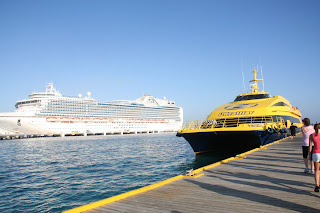 |
| COBA |
 Docking early in Cozumel, we had to be ready to leave the boat by 7am. It would take a boat and a bus to get us to the ancient city of Coba, and the trip would take two hours. One look at the dock told us that it would indeed be a long trip. I think in the early days they must have tendered people ashore because this was the longest dock I had ever seen. They even had their own form of transport to get people to the end of the dock to the stores.
Docking early in Cozumel, we had to be ready to leave the boat by 7am. It would take a boat and a bus to get us to the ancient city of Coba, and the trip would take two hours. One look at the dock told us that it would indeed be a long trip. I think in the early days they must have tendered people ashore because this was the longest dock I had ever seen. They even had their own form of transport to get people to the end of the dock to the stores.
In order to get to the bus that would take us to the ancient Mayan city of Coba to view the ruins, we first had to take a ferry to the mainland at Playa del Carmen. The trip took about 30 minutes in the high speed water taxi.
Playa del Carmen had been built up from a sleepy Mexican tourist town to a chic resort that attracted the rich and famous.
Outside the city limits, however, things were different. The people went about their
business, going to work down a narrow street, selling their wares to keep alive, or walking to school, trying to stay in the shade and out of the heat.
The one thing our tour guide, Raul, wanted to impress on us was that the Mayan civilization did not die out. In fact, he was Mayan. The Mayan language is still spoken, and many aspects of the culture that ruled the world four thousand years ago. The descendants of the original Mayan people still live in Central America and they still carry on with many of their original traditions and beliefs.
One of the most fascinating sights at the ruins was the ball fields. It seems that there was a game where you had to get a heavy rubber ball through one of the hoops. The game was similar to soccer in that you didn't touch the ball with your hands and usually used your hips to move the ball. It was associated with some kind of ritual that usually involved the human sacrifice of one of the players.
The stone tablet that many say predicts the end of the world on December 22, 2012 is located at Coba. The Mayans, however, do not believe that the world is going to end, but rather, that the tablet predicts the beginning of a new era.

The highlight of the site was the great Nohoch Mul pyramid. You can climb to the top see the great panoramic view of the countryside, including the tops of many other pyramids.

We headed back to the bus for the long trip back to the boat. Because the tour included a stop to a Mexican souvenir factor outlet, we were the last group back to the water taxi in Playa del Carmen, consequently the last ones back on the boat. Thank goodness we had booked the tour through the boat, or we might still be in Mexico.
 |
| Trasport through the ruins for the weak at heart like me! |










No comments:
Post a Comment